THE duty of the pick-up is to change the lateral vibrations of the reproducing stylus, as it traces the modulated groove, into an electrical equivalent of the modulation pattern which was imparted during the recording process. It is the aim of the designer of pick-ups to produce a unit whose output signal is an exact replica of the signal which was applied to the recording head when the record was made. Since there are so many mechanical factors involved between the change-over from the electrical to the mechanical at the recording end and the change-over from the mechanical to the electrical at the reproducing end, the designer is presented with a great number of complex problems which, from the hi-fi aspect, are aggravated by the extra pre-emphasis and consequent increased velocity of the reproducing stylus.
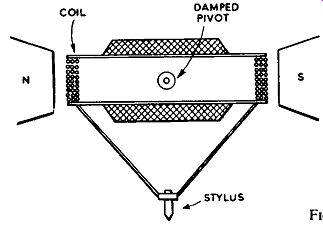
FIG. 7.1. Moving-coil pick-up unit.
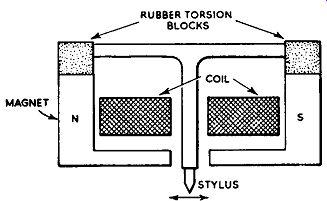
FIG. 7.2. Moving-armature pick-up unit.
Pick-ups can be considered as small generators of electricity. There are two basic types, those whose output voltage is proportional to the velocity of the movement of the stylus, and those whose output is proportional to the force applied to the stylus. The former adopt the electromagnetic principle for the generation of their output voltage and may be likened to the bicycle dynamo whose output voltage is governed by the speed (velocity) of the driving wheel. The latter type rely upon the property of Rochelle salt crystals of producing a potential difference when subjected to changes of pressure.
Electromagnetic pick-ups employ a coil or conductor together with a small permanent magnet; a voltage is set up in the coil or conductor as a result of the variations of magnetic flux caused by the side-to-side movement of the stylus. The stylus is coupled to one or other of the two elements either directly or magnetically.
With the moving-coil pick-up (Fig. 7.1), the coil is directly coupled to the stylus, and the same applies to the ribbon pick-up, which is really a moving-coil unit having a single-turn coil. With the moving-armature pick-up (Fig. 7.2), the stylus is coupled directly to the armature which vibrates in the gap of a magnet supplying the steady field, and the coil is wound over the magnetic circuit. There are several variants of this type of unit, from the older moving-iron and needle armature units to the tiny micro-armature types and the so-called variable-reluctance pick-ups, the latter probably being the most popular of the electromagnetic range.
Whilst all electromagnetic pick-ups, with the exception of the moving coil unit, are essentially variable-reluctance types, it is the pick-up illustrated in Fig. 7.3 which is usually known by this designation. Its operation is quite straightforward; there are two coils wound over the magnetic circuit, which is provided by the small cylindrical permanent magnet, the pole pieces and the ferrous (magnetic material) stylus arm. The stylus arm thus vibrates within the gap between the pole pieces, which causes the flux alternately to increase in one pole and decrease in the other, thus resulting in increasing and decreasing e.m.f's in the associated coils, which are phased so that the voltages are series-aiding.
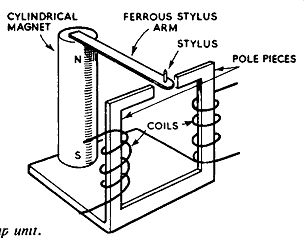
FIG. 7.3. Variable-reluctance pick-up unit.

Fig. 7.4. Moving-magnet pick-up unit.
It is well known that a voltage will be generated in a coil if a varying magnetic flux cuts the turns either by the coil moving in the flux or by the movement of a part of the magnetic circuit. This follows the basic law of electromagnetic induction which was first postulated by Faraday.
Exactly the same effect will be achieved, and a voltage will be developed in an associated coil, if the magnet moves while the other element remains stationary. This principle, which is used extensively in some bicycle dynamos, is adopted in the Philips Novosonic pick-up. The magnet consists of a thin ferrite rod which is magnetized across its diameter, and to which is coupled a cantilever stylus. The magnet thus undergoes a slight twisting movement, due to the lateral movement of the stylus, within the gap of the mu-metal yoke.
As with the variable-reluctance unit, the flux will alternately increase in one side and decrease in the other, resulting in increasing and decreasing e.m.f's in the associated coils. The idea is shown in Fig. 7.4.
The Rochelle salt crystal used in crystal pick-ups is cut from a big crystal at a critical angle and placed between two metallic plates so arranged that the pressure on the crystal is varied in sympathy with the vibrations of the stylus. The crystal element is very fragile and easily broken or damaged by excessive mechanical pressure on the stylus and by high temperature.
Extreme care should, therefore, be taken when replacing the stylus in one of these units. Instead of Rochelle salt crystal, poly-crystalline barium titanate has been used in some recent units. This material is less affected by temperature and humidity, but unfortunately does not lend to the extended frequency range of the Rochelle salt crystal desirable in pick-ups.
PICK-UP MECHANICS
Modern recording technique, resulting in extended high-frequency response, pre-emphasis as a noise-reducing agent, and the long-play micro-groove record, has introduced records with very sharp changes in modulation pattern. Thus, in order to reproduce the modulation impressed upon the grooves of these records with true fidelity and without causing damage to either the pick-up stylus or record grooves, a pick-up whose stylus is able to respond immediately to the rapid accelerations and decelerations is essential.
At high frequencies and recorded levels the accelerations encountered by the stylus may approach some thousand gravities (1000 g). Acceleration involves a variation of either velocity or direction, or both, and the pick-up stylus is subjected to both of these factors when it is tracing the modulated groove of a record. The stylus and associated linkage also possess mass (which is the quantity of the matter contained in the items referred to). As the result of the accelerations of the mass, the stylus is subjected to a force, as we have seen. The magnitude of this force is compared with the force due to the pull of gravity-this being denoted by the letter g. Thus, the force acting on a stylus when it is under the control of a heavily-recorded sound of high frequency may rise to some 1,000 times the pull of gravity-hence the term 1,000 g given above.
In order to prevent the record groove from being torn to pieces, the pick-up stylus must be free to move very easily and rapidly from side to side.
If the pick-up is light and the stylus stiff, the stylus will be unable to respond to sudden large changes in modulation and it will ride up on the groove wall and skate across the record. This is what happens when an old-type pick-up is used on a modern record.
As a means of reducing the mass of the moving parts of a pick-up and ensuring that the effective inertia at the high acceleration rates encountered on modern records is kept as low as possible, very lightweight stylus mounting materials are essential; micro-armatures are often made hollow for this purpose. The modern pick-up rates the mass of the moving parts in milli grams, which is a considerable achievement when it is considered that only a few years ago these parts were rated in ounces, and remembering also the much greater stress imposed upon these parts due to the high recorded velocities of modern records. In this respect, it is interesting to note that the effective mass at the stylus tip of the Goldring variable-reluctance cartridge Type 500 is only 3.5 milligrams! Another factor affecting the free movement of the stylus is the damping arrangement needed in the pick-up to return the stylus and armature to the point of balance in the center of its lateral movement. In the pre-war heavy type of pick-up in which a needle chuck was employed the iron armature was clamped in the center of its movement by hard rubber pads, which invariably perished after a short time. In those days, considerable force was required to promote a lateral displacement of the needle. There was little trouble in tracing the grooves of the old-type records though, since the vertical force on the needle due to the great weight of the pick-up (two or three ounces) left no alternative; the recorded accelerations were also far less than they are today. Nevertheless, neither the needles nor the records lasted very long, and after several playings by this "brute force" method the quality on play back deteriorated sadly. Today, pick-ups track admirably at a pressure of seven to ten grams.
The tracking pressure required is related to the lateral stiffness of the stylus, of lateral compliance as it is known, compliance being the reciprocal of stiffness and rated in centimeter/dynes. Thus, if the compliance is low the movement is stiff and a greater vertical force is required to hold the stylus in the groove. The compliance of hi-fi pick-ups is rarely less than 3·5 x 10^6 cm/dyne.
In addition to the lateral compliance, a vertical compliance is necessary to combat the pinch effect which was described in the previous section. If the pick-up lacked vertical compliance, the whole of the pick-up and the arm would have to follow the vertical movements as the result of the pinch effect.
The inertia of such a large mass would cause the stylus to plough along the groove at high modulation levels and also evoke groove jumping. In such cases the vertical movement of the stylus may be as much as one-tenth of the lateral movement, and for this reason the vertical compliance is generally set in the region of 5 x 10^7 cm/dyne, but it is not always given in the data supplied by the makers.
The cantilever-type stylus, which is formed of a straight or trailing shank on which the sapphire point is mounted, provides by virtue of its design a degree of vertical compliance, which usually satisfies the above condition.
Pick-ups suffer from resonances just as much as other items of audio equipment. The high-frequency resonance is a function of the mass of the moving parts; the smaller the mass the higher the resonant frequency.
With the small mass demanded of hi-fi pick-ups the upper resonance usually falls outside the audible range, around 17-18 k hz. The low-frequency resonance, on the other hand, is usually governed by the tone arm and characteristics of the pick-up head and mounting arrangements. An average arm gives a low-frequency resonance in the region of 20 hz, which is of little moment since the response of the amplifier is pretty well limited at this frequency to avoid motor rumble and low-frequency overloading troubles.
With regard to the pick-up proper, a high compliance in the lateral sense damps low-frequency resonances and keeps them well down the low end of the scale, out of harm's way.
STYLI
There are only two types of stylus used these days, namely, sapphire and diamond. Pick-ups which use metal or fiber needles and needle chucks are useless for hi-fi work and should be discarded. There are dozens of different kinds of styli for use in the many patterns and makes of pick-ups produced over the last few years. It is impossible to go into detail, and in any case there would be little purpose served in so doing. Pick-ups designed for serious hi-fi work usually have available styli in sapphire or diamond. From the actual playing point of view there is no difference between the two, but from the aspect of longevity there is considerable difference.
The rate of wear of any stylus will be governed by a number of factors, including tracking weight and vertical and lateral compliance of the pick-up, the condition of the records, the amount of dust in their grooves and how the equipment is handled. Generally speaking, the life of a diamond stylus is some 20 times that of a sapphire, and under ideal conditions it is often possible to get some 60 hours of playing time from a sapphire. The diamond is much more expensive than the sapphire, however.
The great advantage of the diamond is that it avoids that gradual deterioration in quality which is characteristic of a sapphire as it slides down its life/efficiency curve. A point is reached where replacement becomes necessary from the quality point of view, but not from the aspect of economy.
As a stylus nears the end of its useful life so the rate of wear of the records increases. The quality of the reproduction also suffers considerably not only by loss of the higher frequencies, but also by the introduction of harmonic and intermodulation distortion as the result of the asymmetrical tracing motion of the worn stylus.
Unless a microscope is available to assess the wear of the tip of the stylus, it is good policy to replace the stylus regularly as governed by the type of pick-up employed, and by the maker's recommendations in this respect.
Some dealers make use of the Philips "Needle Clinic" microscope, and such an instrument is well worth acquiring if considerable hi-fi work is contemplated.
STYLUS REPLACEMENT
Extreme care should be observed during the operation of replacing a worn stylus. It is often necessary first to remove the cartridge or head from the pick-up arm. With the A cos SA and SB series, the stylus holder should be lightly gripped with a pair of long-nose pliers or tweezers, while the worn stylus is extracted from the holder with a second pair of pliers or tweezers arranged to lever against the first pair. If undue pressure is applied to the stylus holder, or if this item is not held rigidly without movement while the stylus is being extracted, there is a strong possibility that the internal assembly will be damaged, necessitating replacement of the cartridge as well as the stylus.
Generally speaking, the cantilever-type of stylus can be withdrawn with little difficulty in the way described above, and on replacing care should be taken to ensure that the shank section of the new stylus is pushed well home into the holder or "pocket". The Collaro Studio crystal cartridges use a small machine screw to secure the cantilever-type stylus to the body of the cartridge. Near the jewel end of the cantilever the generating system is mechanically coupled by means of a small pad resting on the cantilever arm. The styli for the types "O" and "P" cartridges have phosphor-bronze shafts, while aluminum shafts are used on the styli for the transcription cartridge, the long-play type having a series of holes drilled along its length.
These various styli have an effect on the overall frequency response of the pick-up, whilst also affecting the output voltage. They are, in effect, tuned to fit in with the various responses of the pick-up itself. On no account should the shape of the shank or cantilever be altered. If, after replacing a cantilever type stylus, it appears that the tracing angle of the jewel is incorrect, the trouble will invariably be caused by incorrect fitment and not by distortion of the shape.
Styli are usually color-coded, red indicating the microgroove variety, and green the 78 r.p.m. type. They should never be interchanged, since the tip radius for microgroove is 0.001 in. and for 78 r.p.m. 0.0025 in.
The cantilever-type stylus, by virtue of its operation as two simultaneous levers operating on the generating coupling, evokes four rather complex resonances. Additional resonances are produced by the formation of the cantilever section proper, as the result of twisting and torsional effects. However, these are smoothed out to provide the required response of the modern hi-fi unit.
There are a number of single pick-up units which can be used to play either 78 r.p.m. or microgroove records, the cartridge having two styli, one for 78 r.p.m. and the other for microgroove, mechanically coupled to either a single generating system or independent generating systems. These are usually called "turnover units" and operate quite successfully. Before this idea was adopted it was necessary to change the head on changing from 78 r.p.m. records to microgroove records.
Another arrangement along these lines is the so-called "turnaround" cartridge. Here the composite cantilever-type stylus is pivoted in its center so that it can be rotated through 180 deg. to bring the required stylus into mechanical coupling with the common generating system. This is an admirable idea, since the requisite damping can easily be given to the styli to maintain optimum results on both types of record.
One problem associated with pick-ups is "needle talk". This is the acoustic rattle that vaguely resembles the modulation on the record which is emitted from the mechanical function of the pick-up itself. This used to be extremely troublesome in the days when heavy pick-ups were used. In fact, the noise used to be so great that it was necessary to use acoustically-treated lids on radiograms to prevent the noise affecting the reproduction from the loudspeaker. (Hence the notice "Please close the lid when playing".) The actual sound radiated from the pick-up and the record (the record contributes towards it) was caused by the rise and fall of the complete pick-up assembly and tone arm due to the pinch effect; the sound was, in fact, second harmonic of that recorded. The trouble these days has been eased by the smaller masses and dimensions of pick-ups and associated parts. Nevertheless, it is still present to some degree and is evoked by the mechanical back lash of the stylus on the record, as the stylus rises and falls at twice the recorded frequency due to the pinch effect. The record in this case serves as a sounding board.
OUTPUT FROM PICK-UPS
The output from pick-ups in terms of voltage is a function of their sensitivity, and is measured in terms of r.m.s. volts for a certain stylus velocity. As an example, the Goldring variable-reluctance cartridge Type 500 is said to have an average output of 3.2 mV per cm/sec. This means that for each cm/sec of stylus velocity the output is 3.2 mV. The recorded velocity is always changing with the program material and pattern so the output voltage changes accordingly. At a recorded level of 5 cm/sec the output from the pick-up would thus be 5 times 3.2 mV, or 16 mV. This is still very low, and requires a high degree of amplification.
Crystal pick-ups provide a greater output voltage and so require less pre amplification. Usually, however, the more hi-fi the pick-up the less its output voltage. This should not be taken as a general rule, but as an approximate guide. It must also be remembered that if equalization is required, the relating network itself absorbs some of the signal power from the pick-up, thus reducing the mV per cm/sec across the output terminals.
SIMPLE EQUALIZING NETWORKS
Let us suppose that we have an amplifier with a perfectly linear response within the workable limits of the audio spectrum, to which it is required to connect a pick-up. The record, it will be remembered from the section on disk recording, has a certain recording characteristic. In terms of velocity, the bass is attenuated and the top frequencies accentuated. If we use a pick-up whose output is proportional to the velocity of the recording (electro magnetic type), the reproduction will be most disappointing; there will be a marked lack of bass and a marked increase in "top". This is because the output voltage over the frequency range follows the recorded curve.
What is wanted is a network which lifts the bass and attenuates the high frequencies to the extent that the bass was attenuated and the high frequencies accentuated during the recording process. The equalizing network should in fact have a response/frequency curve which is the exact inverse of the recording curve. This will correct the output signal from the pick-up and linearize it so that it suits the linear characteristic of the amplifier.
The reproduction will then sound much more "natural". Although it is impossible to match inversely all the various recording characteristics that have been adopted, a fair compromise is possible in practice and final adjustment can be made with the amplifier's tone controls.
With this in mind, it would appear that future amplifiers will need to have provision for only two recording characteristics-those approved by British Standard 1928: 1955 (R.I.A.A.) which was referred to in the previous section.
EQUALIZING CIRCUITS
An equalizing circuit is frequency-selective in a sense which corrects the recording characteristic, whilst also taking into consideration the pick-up and amplifier loading and deficiencies of the response of the pick-up itself.
Assuming that the pick-up does not introduce its own response coloration and that it has a truly constant velocity output, then the equalizing network given in Fig. 7.5 can be used, either between the pick-up and the input of the amplifier (or radio receiver) or after the first voltage-amplifier in the control unit.
If we study the recording characteristic in Fig. 6.5, it becomes obvious that the equalizing network has to perform three functions. It has to lift the bass from about 600 hz; to cut the lower bass at around 50 hz; and to cut the treble around 1,000 hz. It has to do these things to secure an output linear with frequency from the pick-up circuit.
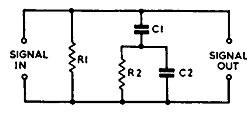
FIG. 7.5. An equalizing network of this kind is often used for modern
recordings in conjunction with high-impedance electro magnetic pick-ups.
So that these various functions can be understood, the circuit in Fig. 7.5 has been broken down into three basic sections which are given in Fig. 7.6.
The circuit at (a) serves to cut the lower bass, that at (b) provides an overall bass boost, and that at (c) cuts the treble. When the circuit is in the composite form given in Fig. 7.5, then it performs all these functions simultaneously.
The actual affect that these frequency-selective circuits have on the overall recording characteristic depends upon the values given to the capacitors C and resistors R. It will be remembered that a resistor and capacitor associated in a circuit form a time-constant T whose value in seconds is equal to the capacitance C in farads multiplied by the resistance R in ohms. The time-constant is extensively used in equalizing networks, its value being given in practice by the following expression: CR= time constant (T) = 10^6/2 pi f, where C is in microfarads, R is in ohms, T is in microseconds and/is in hz. The term/ is known as the turnover frequency, and it is by reference to this that the curves are calculated so that they merge inversely with the recording characteristic curve to produce a linear response.
The turnover frequency is reckoned to be that frequency at which the response--as indicated by the curve--is 3 db below or 3 db above the reference response or datum line. With reference to Fig. 6.5: At about 320 hz the 78 r.p.m. curve is 3 db below the 0 db datum line. Thus, to equalize, a bass boost circuit (Fig. 7.6b) will have to be used whose time-constant suits this frequency. Similarly, in the region of 3,000 hz the same curve is 3 db above the datum, indicating the necessity of a top-cut circuit (Fig. 7.6c) having a time-constant related to this frequency. The lower bass requires cutting at about 40 hz, calling for the use of circuit Fig. 7.6a.
It will be obvious that the same answer for the time-constant T can be secured from a host of C and R combinations. Generally speaking, however, the value for the resistor R1 (Fig. 7.5) is affected by considerations relating to the matching of the pick-up to the amplifier input circuit. It is assumed that the load presented across the output terminals of this kind of circuit will be of high impedance, represented, for instance, by the control-grid circuit of a voltage-amplifier valve. If the network is fed from a source of low impedance, then a resistor should be placed in series with the signal whose value is high in relation to R1. Having fixed the value for R1, in terms of matching, R2 should be arranged to be approximately 12½ times below R1. The time-constant elements associated with Fig. 7.5 are C1, R1 and C2, R2, whose time-constants respectively should be 2,940 microseconds and 81 ·2 microseconds for microgroove records, and 2,780 microseconds and 57.3 microseconds for 78 r.p.m. records.

FIG. 7.6. Frequency-selective networks; (a) for lower bass cut: (b)
for bass lift: and (c) for top cut.

Fig. 7.7. Single-stage amplifier recommended by Goldring for use with
their Type 600 pick-up. The output is 80 millivolts (equalized) at 1,000
hz at a recorded level of 3 16 cm/sec.
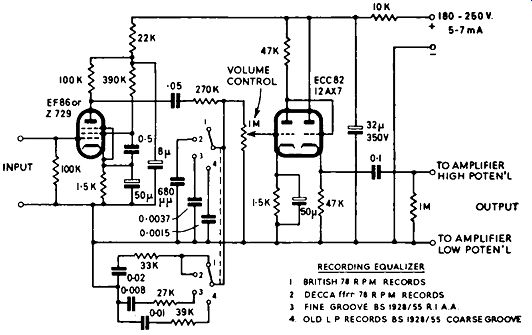
FIG. 7.8. A two-stage Goldring circuit. This is recommended for the
Williamson amplifier and similar units.
All equalizing circuits of the nature described give a signal across their output terminals considerably below the level of the signal applied across their input terminals, and thus attenuate the signal. In certain cases, particularly where the output voltage from the pick-up is low to start with and the amplifier is insufficiently sensitive, or where it is required to connect a low output equalized pick-up signal to the pick-up terminals of a radio receiver or radiogram, a pre-amplifier will be required to make good this attenuation and provide the amplifier with a signal of sufficiently high level to load it fully.
Two such pre-amplifiers recommended by the Goldring Manufacturing Co. for use with their Type 600 variable-reluctance cartridge are shown in Figs. 7.7 and 7 .8. Both circuits provide four degrees of equalization, and the equalizing circuits in both cases follow the low-noise pentode valve. The single-valve circuit provides an output of 80 millivolts at 1,000 hz at a recorded velocity of 3· 16 cm/sec (from the Decca test record LXT5346). Without the amplifier and using the equalizing circuit recommended (see Fig. 7.9 a and b), the output is only about 4 millivolts at a recorded level of some 10^-12 cm/sec. Thus, the single-valve circuit permits this excellent pick-up to be used in conjunction with most makes of hi-fi amplifier.
The two-valve circuit, in which the output is by way of a cathode follower, is recommended for the Williamson amplifier or similar types requiring a very low-impedance input. The Goldring 600 pick-up is intended for operation into a resistive load of approximately 68,000 ohms, and is not intended for use with a transformer.
As the output voltage over the frequency range is dependent not only on the type of equalization network employed, but also on the frequency response of the pick-up, the actual design of an equalizing network is not always as simple as it may first appear. Fortunately, it is rarely necessary for the enthusiast or technician to have to work out networks and component values for specific pick-ups as these are nearly always given in the maker's instructions.

FIG. 7.9. (a) Equalizing network recommended for the Goldring Type 600
pick-up: (b) associated equalization curves.
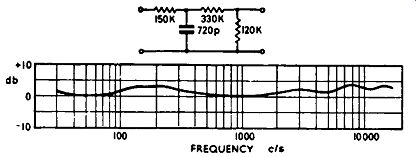
FIG. 7.10. The network recommended/or the A cos Black Shadow pick-up
to provide the substantially linear output shown by the curve for records
cut to B.S.I./R.I.A.A. standards.
CRYSTAL UNITS
The output voltage of a crystal unit is proportional to the force to which the stylus tip is subjected when it is tracing a record. Thus, excluding resonance effects, the open-circuit generated voltage is approximately linear with respect to frequency with reference to the recorded amplitude. Since modem recordings have a characteristic approaching constant-amplitude rather than constant-velocity (due essentially to the bass cut and treble lift), some crystal units, such as the Collaro Studio "O", certain A cos units and others, have an output/frequency curve which is almost the inverse of the recording curve. The replay characteristic is thus automatically secured, and additional equalizing networks are not required. In such cases, the pick-ups can be connected direct to the input terminals of a linear amplifier and acceptable reproduction is obtained.
When using crystal pick-ups of this kind care should be taken to see that they are not connected to an equalized input of an amplifier, otherwise the bass will be overpowering and the top considerably muted, as the result of an effective double-equalizing function. The same trouble would result if a record player whose pick-up signal passes by way of an internal equalizing network is connected to an equalized pre-amplifier input socket. Some record players. such as the Decca, employ internal equalizing so that they can be connected direct to the pick-up sockets of a radio set. Hi-fi players, however, rarely adopt this idea, the pick-up wires coming direct from the pick-up and, unless the crystal types mentioned above are used, they require an equalizing network either externally or in the amplifier. We have seen in the previous sections that switched equalizing circuits are usually incorporated in the pre amplifier or control unit of hi-fi systems.
An essential element in the crystal pick-up is a capacitance formed by the crystal as the dielectric and the plates either side. If this capacitance is loaded by a resistance, then the signal is differentiated and the output will approach the velocity characteristic. The extent of this modification in characteristic depends to a large degree on the response of the pick-up unit itself and the value of the load resistor. This makes it most important that the value stipulated for the resistor by the makers is always used.
Fig. 7.10 shows the network recommended for the A cos Black Shadow pick-up to give the substantially linear output from records cut to the B.S.I./R.I.A.A. standards. The network in Fig. 7.11 should be used to modify the output to the velocity characteristic so that the pick-up can be connected direct to the magnetic input terminals of the control unit. The inclusion of this simple resistor-capacitor network avoids the necessity of having to alter the existing equalizing circuits to cater for the pick-up. Both networks work into an amplifier impedance of 100,000 ohms, while the equalized signal at the output of Fig. 7.10 is approximately 20 mV per cm/sec and 30 mV per cm/sec at the output of Fig. 7.11, thus requiring amplifier sensitivities in the region of 60 mV and 100 mV respectively.

FIG. 7.11. The network recommended for the Acos Black Shadow pick-up
to provide a velocity characteristic as shown by the curve. This enables
the pick-up to be connected by way of the magnetic pick-up terminals
of the control unit.
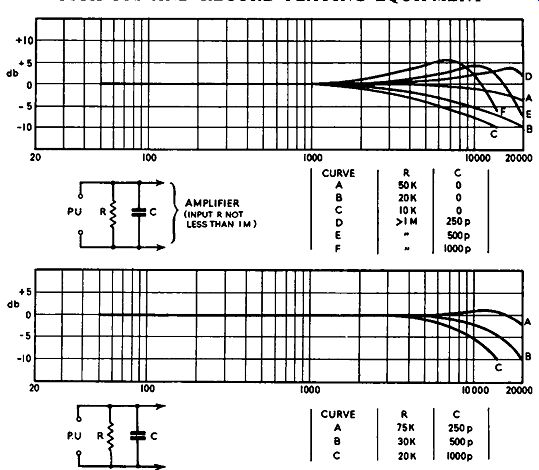
FiG. 7.12. Frequency-response curves of the Goldring Type 500 variable
reluctance cartridge taken under different loading conditions of resistance
and capacitance.
MATCHING
Matching should not be looked upon lightly if best results are to be secured. Fig. 7.12 shows a selection of frequency-response curves of the Goldring variable-reluctance cartridge Type 500 taken under different loading conditions. This shows clearly how the high-frequency response may be considerably impaired by operation of the cartridge with resistive loads other than the optimum value, or with capacitive or combination resistive and capacitive loads.
The effect of capacitance on the circuit is important when it is considered that pick-ups are often connected (of necessity) to the pre-amplifier by way of screened cable whose capacitance value may be in the region of 50 pF per foot of length. Then there are the stray circuit capacitances and the capacitance reflected into the control-grid circuit of the first valve because of the Miller effect. All these capacitances contribute to the general loading and matching of the pick-up, though they cause little trouble (provided the pick-up lead is of reasonable length) if the equalizing network stipulated by the maker is adopted.
Low impedance pick-ups, such as ribbon and moving-coil types, require the use of an impedance-matching transformer, so that the pick-up impedance can be stepped-up to match that of the first valve. Any odd transformer is not suitable; the transformer designed specifically for the pick-up should always be used. Transformers modify the overall pick-up circuit frequency-response, and equalizing circuits designed to suit the pick-up and transformer are always given by the makers.
Low-impedance pick-ups and matching transformers bring with them hum troubles if the correct transformer is not used or if it is situated in a hum field due to a smoothing choke or mains transformer. The transformer should have a good-quality mumetal screen, and screened leads should be used throughout (see also the sections on hum in Sections 2 and 4). In some cases mumetal screens are fitted to low-output magnetic pick-ups so as to avoid hum voltages being induced into the pick-up windings from stray alternating magnetic fields occurring in the neighborhood of the pick-up (e.g., from the turntable motor). The Goldring Type 600 unit uses a light weight mumetal case for this reason and as an added precaution, since the push-pull arrangement of the pick-up coils also serves as a hum-cancelling device.
TURNTABLE UNITS
It is not here intended to delve deeply into the mechanics and principles of turntable units and record changers since full information of this nature can be obtained free of charge on application to the various manufacturers. However, there are one or two points of interest to consider.
Generally speaking, hi-fi enthusiasts are not lovers of record changers; they usually prefer a good-quality four-speed transcription unit. Apart from the skidding of records, one on top of the other, and the resulting wear and speed variation, a lot of the fun of being a hi-fi enthusiast is lost when the need for record changing is eliminated throughout a session. (This view may not be shared by all, but it is the author's personal view and that of his associates!) The turntable unit, whether automatic or not, has to rotate the record at a constant velocity whilst maintaining perfect balance to avoid such effects as wow, flutter and rumble. This is achieved by the use of a carefully designed and balanced turntable having a large proportion of its mass concentrated at its periphery, well-engineered bearings and a good-quality constant-speed driving motor.
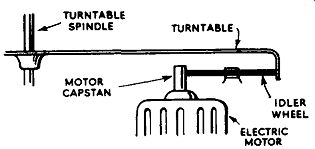
Fig. 7.13. The modern method of turntable drive.
As distinct from the centrifugal-governor type of motor which was popular in the very early days of hi-fi, modern turntable units, including autos, invariably use an induction-type motor to energize the turntable.
Although its speed is governed to a large degree by the frequency of the a.c. mains supply, the induction motor is not truly synchronous, as is an electric clock motor for example. The motor is usually of the four-pole variety, giving a loaded rotor speed of 1,320 r.p.m. or thereabouts.
Some transcription units incorporate a speed adjustment in the form of an eddy-current brake which applies an even load to the motor and thus permits control of the speed over a range of plus and minus 2½ percent.
The Garrard transcription unit has such an arrangement. The load is applied by means of an aluminum disk attached to the rotor shaft passing between the poles of a permanent mag net. The magnet is pivoted in such a way that operation of the speed control increases or decreases the field over the disk.
Another form of speed variation, used in the Goldring (Lenco) transcription unit, takes the form of a speed-cone coupling between the motor and the turntable; adjustment of the speed control alters the position of the coupling wheel on the cone and hence the ratio of the coupling between the motor and the turntable.
In most units, the drive to the turntable is by means of a rubber idler wheel which engages with both a capstan on the motor spindle and the inner edge of the turntable rim (see Fig. 7.13). The turntable speed is controlled by the ratio of the diameters of the motor capstan and the turntable rim. The idler wheel has no direct bearing on the speed of the turntable, a fact which is not always realized. The idler wheel, or jockey pulley, is held under slight pressure between the two drives by means of a spring.
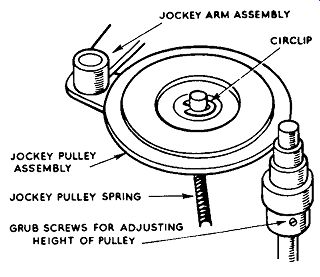
Fig. 7.14. Speed change is effected by a four-speed pulley.
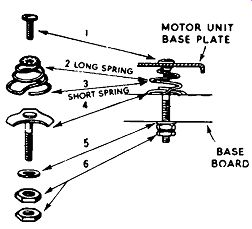
FIG. 7.15. The Goldring-Lenco method of player-unit suspension.
There are various methods in use for obtaining the three or four speeds (16 , 33.3, 45 and 78 r.p.m.). A popular method, employed in B.S.R. changers and players, makes use of a four-speed pulley on the motor spindle and an adjustable jockey assembly. Speed changing is effected by raising or lowering the jockey wheel by a set of levers actuated by a control knob. This arrangement is shown in Fig. 7.14.
The jockey wheel is made of hard rubber, and should circuit therefore be kept absolutely free from oil or grease.
A frequent fault on this type of unit, preventing correct selection of the various speeds, is caused by the four-speed pulley slip ping down the motor spindle as the result of the retaining grub-screws loosening.
Resetting the pulley is a simple matter, as will be seen from Fig. 7.14.
To avoid a "flat" appearing on the rubber idler wheel, the wheel is automatically retracted on some units when the motor switches off at the end of a record or series of records, or when the speed control is set to the "neutral" position.
WOW, FLUTTER AND RUMBLE
Speed variations of the turntable below a frequency of about 20 hz are referred to as wow, since this is the effect given to the reproduction as the result of this fault. The general causes are unbalance in the turntable, slip due to oil on the drive pulleys, a distorted or off-center record, slip of one record upon another on an auto unit, and non-concentricity of the idler wheel.
Flutter refers to speed variations of the turntable above a frequency of about 20 hz. The causes are untrue motor bearings (due to wear in the bearings), unbalance of the rotor, slight eccentricity of the idler wheel or in the mechanical coupling between the motor and turntable, and the transmission of vibrations from the motor affecting the speed of the turntable.
A low-frequency rumble is sometimes superimposed upon the reproduction also as the result of slight unbalance in the motor and drive assemblies, or motor vibrations transmitted to the pick-up way of the idler wheel and turn table. In this respect, resilience of the motor mounting is important, as also is the method of mounting the unit on the motor board. Fig. 7.15 shows the spring mounting arrangement adopted on the Goldring-Lenco transcription units.
Crystal pick-ups are usually more sensitive to motor rumble than their magnetic counterparts, which suffer more from hum pick-up. This is because crystal units are more sensitive to amplitude changes at low frequency than are magnetic types. Sometimes, due to this cause, an acoustical feed back path is promoted between the pick-up and loudspeaker by way of the stylus, record, motor unit and loudspeaker mounting. When this happens a low-frequency howl is emitted from the loudspeaker which can be stopped only by turning down the volume control or removing the pick-up from the record. The trouble is characteristic especially of the portable record player or radiogram in which the loudspeaker is mounted in the same case as the record playing unit.
A microphone valve in the amplifier may evoke a similar symptom, but this trouble can easily be determined by gently tapping each valve in turn with the end of a pencil. Persistent acoustical feedback of this nature should lead to investigation of the spring mounting of the motor unit on the motor board. It should be ascertained that the clamping screws, which secure the motor unit during transit, are either fully released or removed, depending upon their nature, so that the unit is freely suspended upon the springs.
Sometimes it may be necessary to replace the crystal cartridge if acoustical feedback cannot be cleared by other means.
RECORD CHANGERS
When servicing record changers it is always desirable to support the unit at working level on two small boxes. The boxes or blocks should be situated so that they are clear of the mechanism and permit normal operation of the unit. The various operating cycles can be observed by placing a flat mirror on the table or bench beneath the changer. Generally speaking, once the sequence of operations has been carefully observed over several cycles, the cause of the trouble becomes apparent and it requires only a logical approach to apply a remedy. However, if the fault appears complex, or if the action of the sections cannot be understood, the service sheet appropriate to the unit should be studied.
With modern units, the turntable drive is similar to that associated with single players. The intermediate idler wheel is used, and speed change is effected by means of the stepped motor pulley, as already described. There is, however, a secondary drive and cycling mechanism which serves to change the record. This is brought into action by rapid movement of the pick-up when tracing the play-out groove or by operation of the "start" control.
Several things happen as the result of the operation of the cycling mechanism. The next record in the pile on the turntable spindle drops on to the turntable, the pick-up lifts and moves to its setting-down position-this often being determined by the operation of a "feeler" as the record drops-and the cycling action ceases until the pick-up is again moved rapidly by the play out groove or until the "reject" control is turned. When the last record is played the unit switches off automatically, since then the control arm which rests on the pile of records is at its lowest level. There are a number of variations of these actions, but the results are always the same.
The automatic trip which is brought into operation by the play-out groove on the record is common to both auto units and single players, though transcription players do not always employ it. There are two general types operated by either a velocity trip or ratchet. The former type is the most popular and this takes the form of a quadrant which carries a trip lever by way of a friction coupling. The quadrant is coupled to the pick-up arm and moves with it as it traverses the record. At the end of the trip lever is a small felt pad; on the turntable spindle is a striker which makes contact with the felt pad when the pick-up nears the center of the record.
As the record is played the trip lever moves very slowly inward, and at the point where the felt pad makes contact with the striker the trip lever is pushed back against the friction coupling on the quadrant. This action continues at each revolution of the turntable until the trip lever is accelerated by the pick-up stylus tracing the widely spaced play-out groove; the striker then positively engages with the felt pad and pushes the trip lever in such a way that the motor on/off switch is actuated. In some units a turntable break is also brought into action.
The ratchet arrangement includes a lever connected to the pick-up arm to which is attached a lightly loaded pawl. As the arm moves towards the center of the record the pawl rides over a lever-type ratchet which is mechanically coupled to the on/off switch. When the stylus traces the play-out groove the lever which is attached to the pick-up arm oscillates to and fro owing to the eccentric nature of the groove spacing. The pawl thus engages with the ratchet when the movement of the pick-up arm reverses, the associated lever comes into play and the switch disconnects the motor from the mains supply.
With auto units, the trip mechanism starts the cycling action of the record changing mechanism.
These automatic functions are much of a compromise between the mechanics of the unit and the mechanical and electrical nature of the pick up. Whilst modern units present little load on the stylus, the fact that a load is presented to operate the mechanism puts the idea out of favor with hi-fi types. There is, of course, the possibility of impaired tracking and groove jumping as the result of the additional load of the auto-stop mechanism, and a soft, though definite, knock is heard in some units at each revolution of the turntable as the striker makes contact with the felt pad on the trip lever.
For these reasons transcription units use a manual on/off switch.
When servicing auto units, care should be taken to avoid the application of too much oil as several of the functions rely upon friction. The motor bearings themselves are usually of the self-oiling type, though occasionally a few spots of very light oil are required on the felt pads at the seat of the bearings.

FIG. 7.16. The Collaro Conquest record-changer.
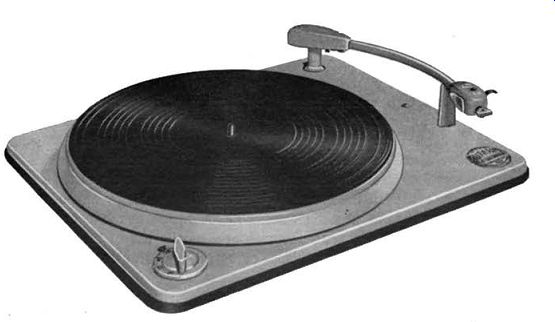
FIG. 7.17. The Collaro 4T200 transcription unit.
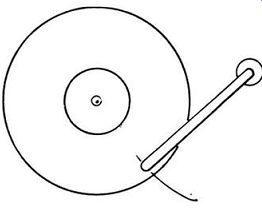
F1G. 7.18. Illustrating tracking error.
The broken line shows the path traced by the recording stylus and the Jul/ line the path traced by the reproducing styli.
With transcription units, the heavy turntable (the weight of the turntable on the Collaro Model 4T200 unit is 8½ lb.) is fitted with a highly machined shaft which runs in a bearing (sometimes self-lubricating) with a steel ball pressed into its lower end. This ball takes the total thrust of the turntable, reduces friction to a remarkably low level and eases wow and rumble problems.
Other features sometimes found are a groove-location device (Goldring Lenco Models GL55 and GL56) which introduces the stylus to the start of the groove, a stroboscopically-marked turntable to determine the accuracy of the speed of the turntable, and a spring- or weight-loaded device on the pick-up arm which can be adjusted to provide a range of stylus pressures.
Figs. 7.16 and 7.17 show the Collaro Conquest record changer and Model 4T200 transcription unit respectively.
TRACKING PROBLEMS
During the recording process the recording head is arranged to move radially across the disk, as shown by the broken line in Fig. 7.18. On replay, however, as the result of the pick-up swinging in an arc about the pivot of the pick-up arm, the stylus follows the full-line curve in Fig. 7.18. This means that over most of the record the oscillations of the reproducing stylus, as the result of the impressed modulation pattern, occur at an angle to those of the recording stylus. The reproducing stylus deviates from the true lateral movement by an amount depending upon this angle of error, usually referred to as "tracking error". Whilst this leads to even harmonic distortion, the stylus has a reduced compliance away from the true lateral movement and greater energy is required to cause it to vibrate, resulting also in greater wear on the sides of the groove where the tracking error is greatest. The tracking error can be kept at a very low figure by mounting the arm so that the tip of the stylus overhangs the center of the turntable by a small amount, by offsetting the pick-up head on the arm at a slight angle, inclined towards the record center (this is catered for during manufacture) , and by the use of an extra-long pick-up arm-there is a limit to this, of course, though 16-in. arms are often used for studio work.
The recommended position for the pick-up, giving the optimum over hang, is stipulated by the manufacturers, often in the form of a template for the initial setting-up of the equipment. There are critical values for over- hang and pick-up head displacement which result in two positions of zero error. For example, an 8-in. arm can be set so that the maximum error at two points is only 2½ deg., while by the use of a 16-in. arm the maximum error can be reduced to 1½ deg. On the other hand, a poorly mounted 8-in. arm and pick-up can lead to an error of some 18 deg., producing considerable distortion at high recorded levels.
A method which virtually cancels the tracking error makes use of a special type of pick-up arm on which the pick-up head carrier is pivoted.
As the stylus traces the groove over the radius of the record so the pick-up swivels on its pivot in a way that counteracts the error. This idea is embodied in the Burne-Jones (B-J) arm.
As already mentioned, the low-frequency resonance of the pick-up system is somewhat governed by the pick-up arm. Hi-fi arms usually have a very low resonance-well below the troublesome level. The Goldring Jubilee arms, for instance, have a resonance in the region of 9 hz. An average arm has a resonance slightly above this figure-15 hz to 30 hz. Other spurious resonances sometimes occur in less exacting arms due to torsional effects.
The bearing friction of pick-up arms should also be at a low level.
This friction is usually measured in terms of the weight required to overcome the friction. A good arm may have a value equivalent to ½-gram, while 4 or 5 grams may represent the value if the bearing is tight or if the arm is poorly designed. The average value is something like 1.5 grams. A high value of bearing friction may promote groove-jumping, particularly if a low tracking pressure is used. Other causes of this symptom are (1) a chipped or worn stylus, (2) the use of a pick-up with too small a value of lateral compliance, particularly when used with modern records of extended frequency range, and (3) a faulty record-this should be suspected if groove-jumping persistently occurs at a certain spot on the record.